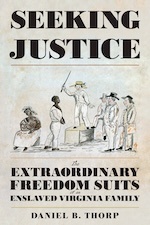Today, we are happy to bring you our conversation with Daniel B. Thorp, author of Seeking Justice: The Extraordinary Freedom Suits of an Enslaved Virginia Family
What inspired you to write this book?
I first came across the file for this case a decade ago while I was working on my book Facing Freedom. The case wasn’t closely linked to the focus of that book, though, and I didn’t want to get sidetracked trying to make sense of a file containing almost 500 pages organized in no discernable way. So I set aside for later. I had seen immediately, though, that the case spanned decades and multiple states, and I kept wondering how it originated and how it turned out. Three years ago, I finally took the time to find out. Over the Christmas holiday I settled down to go through the file and start trying try to make sense of it. The more I read the more fascinating the story became, and I quickly decided that I wanted to share it with others.
What did you learn and what are you hoping readers will learn from your book?
When I started the research, I was aware of cases like that of Dred Scott, but I knew very little about the broader subject of freedom suits – the process by which enslaved individuals sought to gain their freedom through legal proceedings. In the course of exploring the case of Unis Lewis and her family, I learned how common and how controversial freedom suits were in the half century following the American Revolution. More importantly, I learned that the enslaved men and women involved in freedom suits were not just passive objects over which White lawyers argued. They understood the legal process in which they involved and were often active participants in the suits. Unis and her family initiated their suits themselves, they helped their lawyers plan their legal strategy, and they even played a role presenting their case in court. That’s what I was most interested in making more widely known: the extent to which members of this enslaved family were active participants in the legal effort to secure their freedom.
What surprised you the most in the process of writing your book?
What surprised me most was the contrast between statute law and legal practice. The laws of antebellum Viriginia, and of other southern states at the time, were quite explicit in restricting the legal status and rights of all African-Americans and especially the status of those held in slavery. Legally the enslaved were property with no more standing in a courtroom than any other form of property. In freedom suits, though, enslaved plaintiffs often enjoyed a status closer to legal personhood than I would ever have expected from reading the text of the laws. They were certainly not treated equally; they could not testify as witnesses, for example. They did, however, appear in court and in some instances addressed the court and were heard by the court on matters concerning the suits in which they were a party. It was, for me, the most surprising element of the active role that Unis and her family played in advancing their freedom suits.
What’s your favorite anecdote from your book?
Putting a name on a famous picture. Lewis Miller was a carpenter who made hundreds of ink and watercolor sketches of daily life in Pennsylvania and Virgina between the 1790s and 1870s. In Viriginia, he made a number of sketches that have often been used to illustrate different aspects of the antebellum slave trade. One of these is a picture of “Miss Fillis and child, and Bill, Sold at publick sale” that I had seen in a number of books and articles about slavery and the internal slave trade. Whenever I saw it I wondered who Fillis and Bill were and what had happened to them, and now I think I know. Based on the evidence that I found in the course of writing my book, I am convinced that Fillis, and perhaps Bill, was among the plaintiffs in the freedom suit the book follows. They are no longer anonymous subjects in a familiar sketch; they are real individuals with names and histories we can know.
What’s next?
I’m not sure. Several years ago I wrote an article about the experiences of enslaved people in Montgomery County, Virginia during the Civil War. Some of the material in that article came from a small number of letters written by a Confederate soldier to his enslaved workers while he was serving in the Army of Northern Virginia. I’m now in the process of transcribing all of the letters in that collection but am not sure what, if anything, I’ll do with them. The author was a member of the famous Stonewall Brigade and his letters describe both the combat endured by the brigade but also the daily life of its members in camp and on the march. They also provide a wonderful glimpse of the effort made by their author to remain a member of his family and of his community back home while on active duty in the army. I don’t yet know where this will lead -- perhaps to an annotated collection of the letters or perhaps part of something else. But for now I’m having great fun reading and transcribing the letters.





